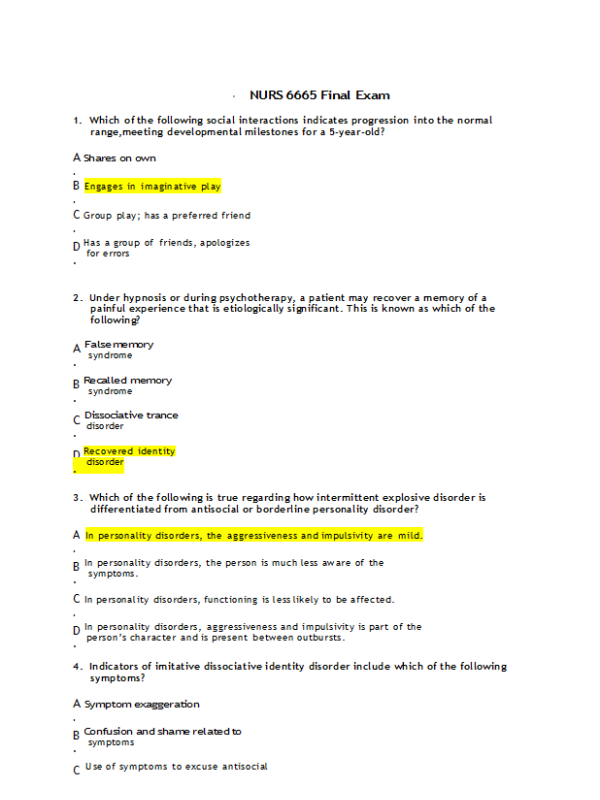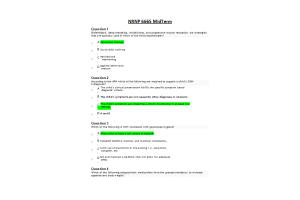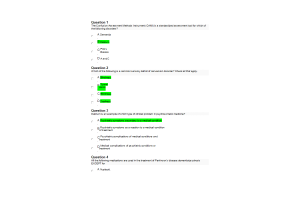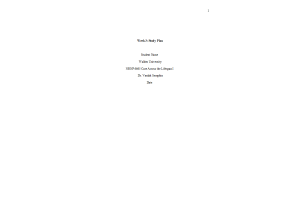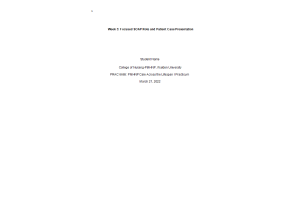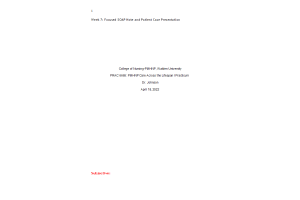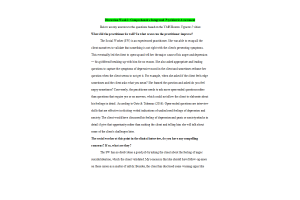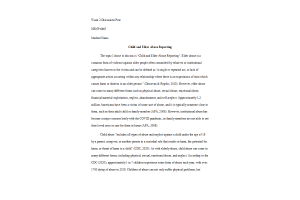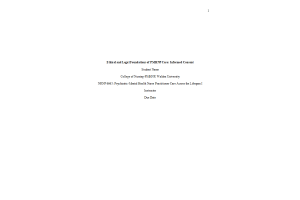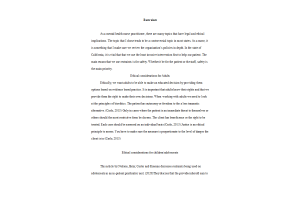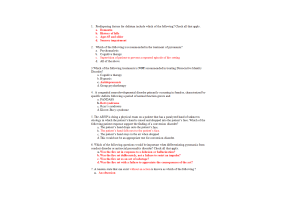NURS 6665 Week 11 Final Exam (100% Correct Summer QTR)
- $49.00
1.Question: Which of the following social interactions indicates progression into the normal range, meeting developmental milestones for a 5-year-old?
2.Question: Which of the following social interactions indicates progression into the normal range, meeting developmental milestones for a 5-year-old?
3.Question: Under hypnosis or during psychotherapy, a patient may recover a memory of a painful experience that is etiologically significant. This is known as which of the following?
4.Question: Which of the following is true regarding how intermittent explosive disorder is differentiated from antisocial or borderline personality disorder?
5.Question: Indicators of imitative dissociative identity disorder include which of the following symptoms?
6.Question: Which of the following would be a developmental trigger for a 3-year- old? Check all that apply.
7.Question: A child who demonstrates repetitive significant violations of social rules and the rights of others over the course of a year would likely be diagnosed with which of the following diagnoses?
8.Question: Experiences of depersonalization and derealization are common in which of the following patients?
9.Question: Which of the following is consistent with what is known about treating individuals with kleptomania?
10.Question: Which of the following biological factors have been associated with kleptomania? Check all that apply.
11.Question: A type of delirium characterized by cycling through psychomotor agitation and retardation, from apathy to hypervigilance is known as which of the following?
12.Question: Most patients with dissociative identity disorder meet criteria for which of the following?
13.Question: A patient presents reporting acute amnesia and fugue episodes in addition to recurrent blackouts, unexplained possessions, and fluctuations in skills, habits, and knowledge. The ARNP recognizes this is consistent with which of the following?
14.Question: Which of the following are included in the five different milestone skill areas that should be evaluated?
15.Question: An episode of acute violent behavior for which the person claims amnesia is known as which of the following?
16.Question: Which of the following would be a developmental red flag that would trigger further assessment for a 2-year-old?
17.Question: or a general medical condition which causes clinically significant distress or impairment in social, occupational, or other important areas of functioning is most specifically known as which of the following?
18.Question: The ARNP notices the 6-month-old does not have a spontaneous smile response and realizes which of the following?
19.Question: cognitive assessment should include which of the following?
20.Question: Interest in fires and deliberate setting of fires for financial gain is known as which of the following?
21.Question: An illness of symptoms or deficits that affect voluntary motor or sensory functions, which suggest another medical condition but that is judged to be caused by psychological factors because the illness is preceded by conflicts or other stressors in known as which of the following?
22.Question: A child 0–3 months would be expected to be able to do which of the following?
23.Question: Which of the following questions would be important when differentiating pyromania from conduct disorder or antisocial personality disorder? Check all that apply.
24.Question: In treating a patient with dementia and a co-occurring depression, which of the following symptoms should be treated first?
25.Question: Which of the following is NOT consistent with what is known about intermittent explosive disorder across the lifespan?
26.Question: Which of the following can cause delirium? Check all that apply.
27.Question: Precipitating factors for delirium do NOT include which of the following?
28.Question: A category of disorders characterized by the inability to resist an intense impulse, drive, or temptation to perform a particular act that is obviously harmful to self or others or both is known as which of the following?
29.Question: Deficits in attention and the ability to complete multi-step commands are associated with impairment in which of the following regions of the brain?
30.Question: Which of the following is consistent with what is known about electroconvulsive therapy (ECT) use in patients with Dissociative Identity Disorder (DID)?
31.Question: The diagnosis formerly known as multiple personality disorder is now known as which of the following?
32.Question: A process by which repressed material is brought back to consciousness and the person relives the repressed material accompanied ty the appropriate affective response.
33.Question: atients who simulate, induce, or aggravate illness to receive medical attention, regardless of whether or not they are ill, would be diagnosed with which of the following disorders?
34.Question: An unconscious defense mechanism involving the segregation of any group of mental or behavioral processes from the rest of the person’s psychic activity is known as which of the following?
35.Question: Persons who continually use the internet to play games to the extent that it interferes with social relations and work performance are exhibiting symptoms most specifically consistent with which of the following conditions?
36.Question: Which of the following is consistent with dementia in HIV?
37.Question: Which of the following statements is consistent with literature about the epidemiology of pyromania?
38.Question: The principal theoretician to bring psyche and soma together was which of the following?
39.Question: eficits in language including naming, repetition, reading and comprehension, and writing is NOT associated with impairment in which of the following regions of the brain?
40.Question: A tension state that can exist without an action is known as which of the following?
41.Question: Schizophrenia in a patient with end-stage renal disease is an example of which type of clinical problem in psychosomatic medicine?
42.Question: ntotemporal dementia with onset in the fifth to sixth decade of life, more common in men, marked by personality change and cognitive decline, is known as which of the following?
43.Question: 6Genetic, imaging, and pharmacological studies support the hypothesis that ADHD is based on which of the following?
44.Question: A dissociative disorder described as an identity disturbance due to prolonged and intense coercive persuasion is known as which of the following?
45.Question: Which of the following questions are recommended to assess sexual identity in a male adolescent?
46.Question: According to a psychodynamic perspective, depersonalization and derealization are understood as which of the following?
47.Question: The term psychosomatic literally refers to which of the following?
48.Question: A dementia which usually occurs in the sixth decade of life, characterized by gradual onset and progressive decline without focal neurological deficits
49.Question: He therapeutic approach that has the best chance of success for the person with intermittent explosive disorder is which of the following?
50.Question: The ARNP is working with the family of a patient with Alzheimer’s Disease who keeps stating the family is plotting against her, trying to have her “snuffed out.” The family is distraught because they state they are doing their best to make sure their family member is safe. The ARNP explains which of the following in educating the patient about the patient’s
51.Question: Which of the following medications are FDA-approved medications for the treatment of delirium?
52.Question: The ARNP evaluates a 4-year-old who cannot balance on one foot for 3 seconds, cannot copy a circle and realizes which of the following?
53.Question: Difficulty with immediate memory is attributed to impairment in which of the following regions of the brain? Select all that apply.
54.Question: Which of the following supports a good prognosis for a person with a conversion disorder?
55.Question: An increase in depersonalization is seen with the depletion of which of the following?
56.Question: A term use to describe a neurodevelopmental disorder characterized by impairments in reciprocal social communication and a tendency to engage in repetitive stereotyped patterns of behaviors, interests and activities is
57.Question: Differential diagnoses to be considered when diagnosing Ganser syndrome include which of the following?
58.Question: The ARNP notices that a patient with a conversion disorder unable to walk has an inappropriately cavalier attitude toward what seems to be a major impairment and recognizes this an associated psychological symptom known as which of the following?
59.Question: A person erroneously believes they sustained an emotional or physical trauma in early life is known as which of the following?
60.Question: There is significant overlap in symptoms of dementia and delirium, however the distinguishing feature is which of the following?
61.Question: Which of the following approaches/treatments are recommended in working with patients with a conversion disorder?
62.Question: Which of the following is NOT considered a nonpathological form of amnesia?
63.Question: he Confusion Assessment Methods Instrument (CAMI) is a standardized assessment tool for which of the following disorders?
64.Question: Delirium is an example of which type of clinical problem in psychosomatic medicine?
65.Question: A disorder characterized by the presence of two or more distinct identities which differ from each other in that each presents as having its own pattern of perceiving, relating to, and thinking about the environment and self.
66.Question: Predisposing factors for delirium include which of the following? Check all that apply.
67.Question: Which of the following diagnostic instruments for Autism Spectrum Disorder is recommended for universal clinical practice?
68.Question: A capacity evaluation prior to an organ transplantation is an exampleof which of the following clinical problems in psychosomatic medicine?
69.Question: A temporary marked alteration in the state of consciousness or by the customary sense of personal identity without the replacement by an alternate sense of identity is known as which of the following?
70.Question: Which of the following is consistent with current literature about the relationship between obstetrical complications and Autism Spectrum Disorders (ASD)?
71.Question: A major neurocognitive disorder with severe impairment in memory, judgment, orientation, and cognition is known as which of the following?
72.Question: Which of the following would not be included in the treatment plan for a patient with illness anxiety disorder?
73.Question: Which of the following would demonstrate the normal achievement of gross motor developmental milestone for a 6-month-old?
74.Question: Which of the following is consistent with normal range gross motor developmental milestones for a 4-year-old?
75.Question: Which of the following speech and language skills are consistent with normal developmental milestones of a 3-year-old?
76.Question: Which the following medications is used to treat irritability in autism
77.Question: A congenital neurodevelopmental disorder primarily occurring in females, characterized by specific deficits following a period of normal function growth and development is
78.Question: Recognizable skills or abilities that have an expected range and order of appearance such as a child taking his first step around the time of his first birthday is known as which of the following?
79.Question: A condition characterized by the person giving approximate answers, with clouding of consciousness, frequently accompanied by hallucinations or other dissociative, somatoform or conversion symptoms is
80.Question: Somatoform disorders represent which type of clinical problem in psychosomatic Medicine?
81.Question: Which is NOT consistent with what is known about Ganser syndrome?
82.Question: The second-most common type of dementia caused by cardiovascular and cerebrovascular disease with progressive cognitive decline in stepwise fashion is known as which of the following?
83.Question: A new diagnosis in the DSM-5 characterized by persons preoccupied with being sick or developing a disease of some kind is known as which of the following?
84.Question: A subcortical dementia characterized by motor abnormalities including psychomotor slowing, choreoathetoid movements, executive dysfunction complicated by impaired language, memory, and insight later in the disease process is
85.Question: MRI findings in patients with intermittent explosive disorder may reveal changes to which area of the brain that is associated with loss of impulse control?
86.Question: A patient presents with persistent feelings of detachment from one’s self, like watching one’s self in a movie. The ARNP recognizes this as which of the following?
87.Question: Which of the following is not consistent with what is known about the epidemiology of dissociative fugue?
88.Question: N-Methyl D-aspartate glutamate receptor antagonists are used to treat dementia by doing which of the following?
89.Question: Which of the following adaptive skills are consist with normal range developmental milestone of an 18-month-old?
90.Question: The ARNP is doing a physical exam on a patient that has a paralyzed hand of unknown etiology in which the patient’s hand is raised and dropped into the patient’s face. Which of the following patient responses support the finding of a conversion disorder?
91.Question: Visual hallucinations are associated with impairment in which of the following regions of the brain?
92.Question: Which of the following are common disorders that must be differentiated from dissociative identity disorder? Check all that apply.
93.Question: The ARNP is meeting with a person who reports a fascination with fire, along with recurrent deliberate and purposeful setting of fires. The ARNP realizes that these behaviors are consistent with which of the following disorders?
94.Question: A type of delirium characterized by psychomotor retardation and apathy is known as which of the following?
95.Question: Which of the following is true about impulses? Check all that apply.
96.Question: Which of the following are included in the clinical features of anxiety illness disorder? Check all that apply.
97.Question: Which of the following shows normal developmental visual motor skill for an 18-month-old?
98.Question: Which of the following is an example of a medical complication of psychiatric conditions or treatment?
99.Question: A precipitous onset prion disease, with rapid decline, progressing to death within 6 months of onset is known as which of the following?
100. Question: A disorder characterized by 6 or more months of general and no delusional preoccupations with fears of having a serious disease based on a person’s misinterpretation of bodily symptoms that causes significant distress and impairment in one’s life is
